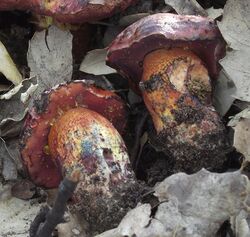Biology:Exsudoporus permagnificus
| Exsudoporus permagnificus | |
|---|---|

| |
| Scientific classification | |
| Kingdom: | |
| Division: | |
| Class: | |
| Order: | |
| Family: | |
| Genus: | |
| Species: | E. permagnificus
|
| Binomial name | |
| Exsudoporus permagnificus Pöder (1981)
| |
| Synonyms | |
| |
Exsudoporus permagnificus is a species of bolete fungus in the family Boletaceae, native to Southern Europe and Western Asia (Cyprus and Israel).[1][2] Described as new to science in 1981, the fungus was originally placed in genus Boletus.[3] Following molecular studies outlining a new phylogenetic framework for Boletaceae,[4][5] the fungus was transferred to the newly erected genus Exsudoporus in 2014, to which it is the type species.[6] Nevertheless, Wu and colleagues (2016) were reluctant to accept the newly proposed genus due to a lack of sufficient sequences and regarded it a synonym of Butyriboletus.[7] Following studies reinstated the status of Exsudoporus as a monophyletic genus sister to Butyriboletus, following additional collections and extended phylogenetic and morphological analyses.[8][2]
Exsudoporus permagnificus is rare throughout its distribution area and listed as a vulnerable or endangered species in a number of regional and national checklists.[9][10][8] It forms ectomycorrhizal associations with oaks (Quercus), particularly Quercus suber, Quercus ilex, Quercus pubescens, Quercus alnifolia, Quercus calliprinos, Quercus pyrenaica and less often with sweet chestnut (Castanea sativa).[1][11][8][2]
References
- ↑ 1.0 1.1 Muñoz JA. (2005). Fungi Europaei 2: Boletus s.l.. Italy: Edizioni Candusso. ISBN 978-88-901057-6-0.
- ↑ 2.0 2.1 2.2 "Reappraisal of the Genus Exsudoporus (Boletaceae) Worldwide Based on Multi-Gene Phylogeny, Morphology and Biogeography, and Insights on Amoenoboletus". Journal of Fungi 8 (2): 2–25. 2022. doi:10.3390/jof8020101. PMID 35205856.
- ↑ Pöder R. (1981). "Boletus permagnificus spec. nov. – ein auffallender Röhrling der Sektion Luridi Fr. assoziiert mit Eichen" (in German). Sydowia 34: 149–56.
- ↑ "Phylogenetic overview of the Boletineae". Fungal Biology 117 (7–8): 479–511. 2013. doi:10.1016/j.funbio.2013.04.008. PMID 23931115.
- ↑ "Molecular phylogenetic analyses redefine seven major clades and reveal 22 new generic clades in the fungal family Boletaceae". Fungal Diversity 69 (1): 93–115. 2014. doi:10.1007/s13225-014-0283-8.
- ↑ Vizzini A. (August 22, 2014). "Nomenclatural novelties". Index Fungorum (183): 1. http://www.indexfungorum.org/Publications/Index%20Fungorum%20no.183.pdf.
- ↑ Wu G, Li YC, Zhu XT, Zhao K, Han LH, Cui YY, Li F, Xu J, Yang ZL. (2016). One hundred noteworthy boletes from China. Fungal Diversity 81(1): 25–188.
- ↑ 8.0 8.1 8.2 "Present status and future of boletoid fungi (Boletaceae) on the island of Cyprus: cryptic and threatened diversity unraveled by 10-year study.". Fungal Ecology 41 (13): 65–81. 2019. doi:10.1016/j.funeco.2019.03.008.
- ↑ Gyosheva MM, Denchev CM, Dimitrova EG, Assyov B, Petrova RD, Stoichev GT (2006). Red list of fungi in Bulgaria. Mycologia Balcanica 3(1): 81–87
- ↑ Karadelev M, Rusevska K. (2013). Contribution to Macedonian red list of fungi. In: Proceedings of the 4th Congress of Ecologists of Macedonia with International Participation, Ohrid, 12–15 October 2012, Skopje. Macedonian Ecological Society, pp. 68–73. Special issue 28.
- ↑ Galli R. (2007) (in Italian). I Boleti. Atlante pratico-monographico per la determinazione dei boleti (3rd ed.). Milano, Italy: Dalla Natura.
External links
Wikidata ☰ Q4939363 entry
 |

